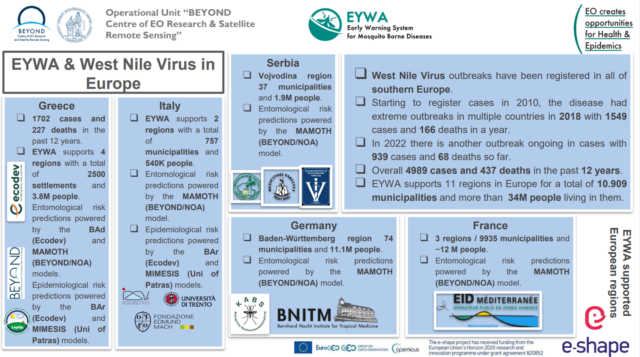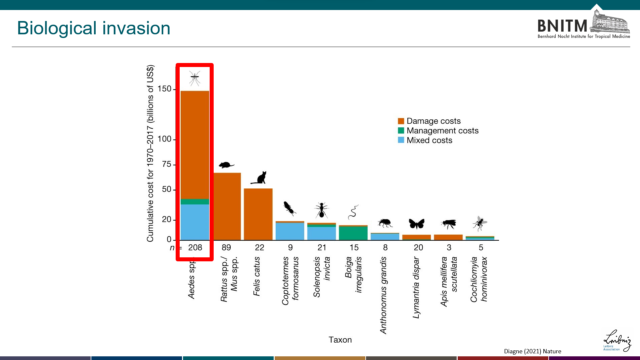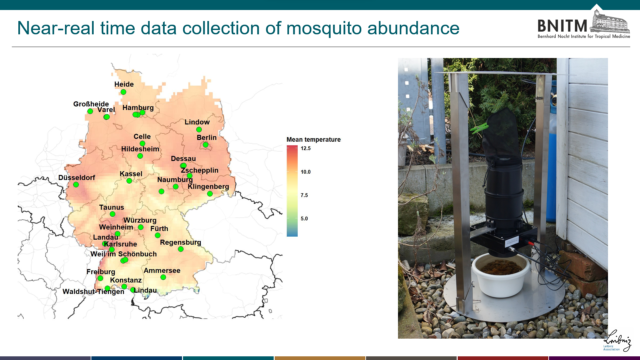Eurisy Members’ Corner: Focus on the BEYOND Center of EO research and satellite remote sensing

Unveiling the EYWA System, from the challenge…to the solution! 26th May 2023
The EarlY WArning System for Mosquito-borne Diseases (EYWA) was developed in the context of the EuroGEO Action Group “Earth Observation for Epidemics of Vector-borne Diseases – EO4EViDence”.
EYWA is a game changer in the domain of epidemics. The solution enhances mosquito surveillance and control at various spatio-temporal scales and in different climatic zones, and guides day-to-day prevention and mitigation actions. EYWA significantly reduces the entomological risk and results in the aversion of human cases in thousands of villages where it is employed.
This second episode of the Eurisy Members’ Corner series of 2023 was designed and moderated by Dr Haris Kontoes, Head of the Operational Unit BEYOND Centre of EO research and satellite remote sensing of the National Observatory of Athens, Coordinator of EuroGEO Action Group for Epidemics, and Lead Partner of EYWA.
The BEYOND Center of Excellence develops research and provides disaster management services addressing priorities and needs in Southeastern Europe, the Mediterranean area, North Africa, the Middle East and the Balkans.

Dr Kontoes explained that mosquito-borne diseases (MBDs) are present in more than 100 countries all over the world, including Europe, causing 700.000 deaths every year.
The EarlY WArning System for Mosquito-borne Diseases (EYWA) was developed in the context of the EuroGEO Action Group “Earth Observation for Epidemics of Vector-borne Diseases – EO4EViDence”.
The technological novelty of EYWA lies in the efficient handling of multiple data sources, such as entomological, epidemiological, Earth Observation, crowd and ancillary geospatial data, along with dynamic and data-driven models to generate knowledge on mosquitoes’ abundance and pathogens’ transmission.
Thanks to data provided by Copernicus satellites and Copernicus Core Services, EYWA reliably depicts the dynamics of mosquito habitats and breeding sites. The system capitalises on European investments in Earth Observation and cloud-based data repositories and capacities (i.e. DIAS, GEOSS, NextGEOSS).

Since 2020 the system has been operational in Europe, and in 2022 it provided operational support for 11 regions in 5 European countries (France, Germany, Greece, Italy, and Serbia). In 2022, EYWA further expanded its operational capacity by adding a new region in Italy and in Ivory Coast, and its pre-operational capacity in Thailand and Ghana, with the goal of covering and supporting regions with different climatic and socioeconomic conditions. In total, the system benefits 14 regions in eight countries across the globe.
This distinction of the EYWA system makes it a significant milestone and an exceptional example of the vast Earth Observation potential and of the societal benefits that can derive from harnessing space technology.

EYWA provides information on the expected mosquito abundance and pathogen transmission to the health authorities in the form of thematic maps and statistics, to enable them to take preventive measures in time.

Dr Konstantinos Tsaprailis, Research Associate & Technical Project Manager at BEYOND, described in detail how the system works to disseminate data and predictions.
In-situ data and Earth observation data are at the heart of the system, and are combined with entomological, epidemiological, socio-economic, meteorological, and geomorphological data.
36 statistical features are generated for each of the 42.400 mosquito collections in the EYWA database. The system processes more than 300 TB of Earth Observation data to generate the information that is then made available to health authorities and stakeholders through an online dashboard.

In 2022, the system was generating data on 13 regions in seven countries and in 2023 it will expand its capacity to cover three more regions in Europe (Italy and Germany) and in Africa (Ghana).

Two types of predictions are at the core of the system: the West Nile Virus prediction models and the mosquito abundance models, that provide forecasts on the expected mosquito population in a region.

The WNV risk prediction relies on the MIMEMIS model, providing forecasts at the municipality level, and the Bar model, producing weekly predictions at the settlement/village level.
The mosquito abundance predictions are based on the BAr model, offering weekly forecasts at the settlement level, and the MAMOTH model, offering bi-weekly and monthly predictions for larger areas.
In summary, EYWA sets the stage for the creation of a single and global database of entomological and epidemiological data augmented with EO-derived data. The system enables for the creation of advanced data-driven and deterministic models for mosquito abundance and risk mapping.
The platform supports the visualisation of the global entomological and epidemiological datasets and it also allows stakeholders to visualise model predictions, representing a complete state-of-the-art early warning system.

After the general introduction to the EYWA system, the webinar included the presentation of three use cases in specific areas.

The first was showcased by Dr Daniel Wohlgemuth, from the German Mosquito Control Association (KABS). Dr Wohlgemuth described the use of the system for targeted vector monitoring in the upper Rhine valley in Germany. The region suffers from a disturbing abundance of mosquitos every time it is affected by floods.

Traditionally, KABS would monitor and forecast mosquitos’ abundance through sampling traps. With EYWA, they could perform this work with consistent savings in terms of time and resources.

The second use case was showcased by Dr Renke Luehken, Head of the Department of Arbovirology & Entomology at BNITM, in Hamburg. Dr Luehken gave aa presentation on the ecology of mosquito-borne pathogens in Europe.

Biological invasions are responsible for substantial biodiversity decline, as well as for high economic losses to society and for monetary expenditures associated with the management of these invasions.
The BNITM tries to understand which mosquitos are associated with which diseases and in which temperatures they tend to settle.
In the last years, because of rising temperatures, two types of vector-borne diseases have emerged in Germany, the Usutu virus and the West Nile virus.

BNITM is collecting data on mosquitos’ abundance in almost-real time and these data will be embedded in the EYWA system to enhance its predictions in central Germany.

Dr Julien Zahouli, from the Centre Suisse de Recherches Scientifiques en Côte d’ivoire, was expected to present a third use case on the use of Earth Observation data to assess environmental and climatic impacts on mosquito-borne disease transmission in Côte d’Ivoire. Because of connection problems, Dr Zahouli was not able to contribute the webinar, but his presentation is made available at the bottom of this article.
To know more about the activities of the Operational Unit BEYOND Center of EO research and satellite remote sensing of the National Observatory of Athens visit: http://beyond-eocenter.eu/
The presentations of the webinar are available here:
- Unveiling the EYWA System | From the challenge…to the solution, Dr Haris Kontoes, Research Director of NOA | Operational Unit “BEYOND Center for Earth Observation Research and Satellite Remote Sensing”; Coordinator of EuroGEO Action Group for Epidemics & Lead Partner of EYWA
- The EYWA platform: Data & predictions dissemination, Konstantinos Tsaprailis, Research Associate & Technical Project Manager, Operational Unit “BEYOND Center for Earth Observation Research and Satellite Remote Sensing”
- Potential utilisation of EYWA for targeted vector monitoring in the upper Rhine valley, Germany, Dr Daniel Wohlgemuth, KABS – German Mosquito Control Association
- Ecology of mosquito-borne pathogens in Europe, Dr Renke Luehken, Head Department of Arbovirology & Entomology, BNITM Hamburg
- Using Earth Observation data for assessing environmental and climatic impacts on mosquito-borne disease transmission in Côte d’Ivoire, Dr Julien Zahouli, Centre Suisse de Recherches Scientifiques en Côte d’ivoire
The recordings can be accessed here: https://youtu.be/B9ZGtEh6zYA
